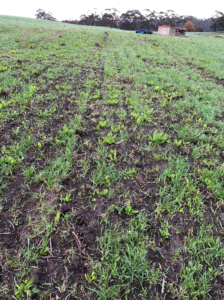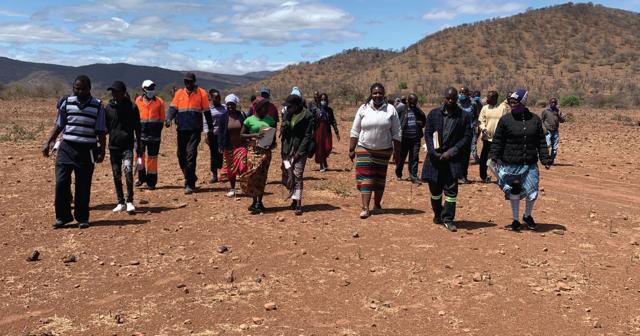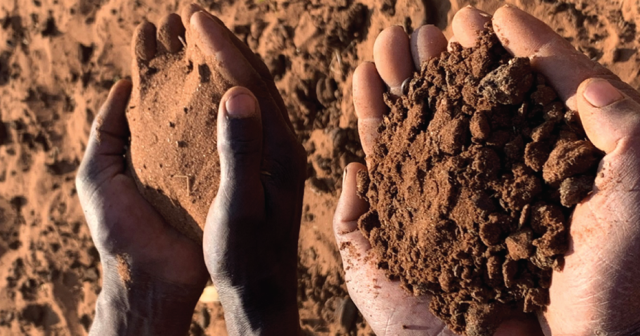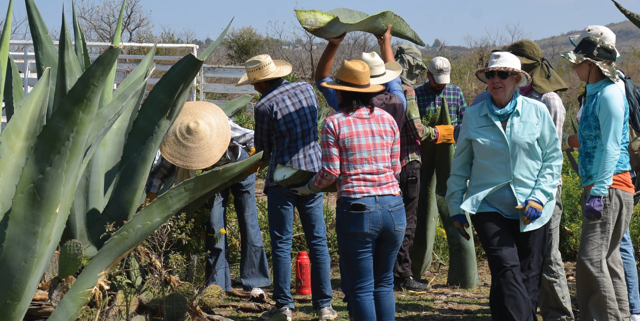Record Temperatures in the Global South: The Effect of Change of Land Use and Deforestation Becomes More and More Patent Through the Changes of Temperature
The case for Regeneration: It has never been more urgent
We have reached a point in time where more and more people are feeling the effects of climate change in their everyday lives. The loss of biodiversity is becoming more evident, we are witnessing more floods and droughts, the world is becoming hotter and fires are more frequent and devastating.
The time for change is now, and it will take all of our global efforts to embrace frameworks that lead us to being better managers of our environments as well as help us pick on best practices, mobilize and address the root causes of the problems we are facing.
This year for our newsletter we want to start sharing with you dispatches from the field: updates on what is happening globally and messages of hope and resilience that could turn the tide.
Australia Update
Andre Leu, International Director of Regeneration International
Why is it so Important to Dramatically Reduce the Current Rate of CO2 Emissions?
If emissions are not reduced soon, all of us will be badly affected by catastrophic climate change. This is because it will take centuries to get the heat out of our oceans. Ocean heat is a significant driver of our weather. The oceans and the atmosphere are more than 1 degree Celsius warmer than the industrial revolution.
The energy needed to heat the atmosphere and the ocean by 1degree is equivalent to billions of atomic bombs. I am using this violent metaphor so that people can understand how much energy is being released into our atmosphere and oceans and why we will get more extreme weather events wreaking havoc on our communities and environment.
This extra energy is already violently fueling and disrupting our weather systems. It is causing weather events to be far more intense. Winter storms are becoming colder and can be pushed further south and north than normal due to this energy, bringing damaging snowstorms and intense floods. Similarly, summer storms, especially hurricanes, tornadoes, tropical lows etc. are far more intense with deluging destructive rainfall and floods. Droughts and heat waves are more common and are resulting in more crop failures. They are also fueling damaging forest and grass fires that are burning out whole communities and changing regional ecologies due to not allowing time for recovery before the next fires.
The frequency and intensity of these types of events will only get exponentially worse when the world warms to 2 degrees Celsius which is the upper limit of the Paris climate agreement. We are on track to shoot far past this goal.
Managing climate change is a major issue that we have to deal with now.
Atmospheric CO2 levels have been increasing at 2 parts per million (ppm) per year. Despite the global economic shut down as a response to the COVID-19 pandemic CO2 levels still set a new record of 420ppm in April 2021. This is a massive increase in emissions per year since the Paris Agreement and shows the reality is that most countries are not even close to meeting their Paris reduction commitments and many must be cheating on or ignoring their obligations.
The United Nations Paris Agreement proposes net CO2 neutrality by 2050. The evidence shows this will too late to the stop the enormous damage of catastrophic climate change. At the current rate of emissions there would be close to 500 ppm of CO2 in the atmosphere.
The fact is we are in a serious climate emergency now. We must speed up the transition to renewable energy, stop the clearing of all forests and we have to make a great effort to drawdown CO2 in the atmosphere to the pre industrial level of 280 ppm.
Why Regenerative Agriculture?
Regenerative agriculture is based on a range of food and farming systems that use the photosynthesis of plants to capture CO2 and store it in the soil as soil organic matter. The soil holds almost three times the amount of carbon than the atmosphere and biomass (forests and plants) combined.
There are numerous regenerative farming systems that can sequester CO2 from the atmosphere through the photosynthesis and turn this into soil organic matter through the actions of the roots and soil biology – the soil microbiome.
According to the Australia Climate Council the cost of extreme weather events in Australia has nearly doubled since the 1970s. Their report shows that the impact of fires, floods, droughts, storms and sea level rise linked to climate change could cost Australia a $100 billion every year by 2038.
The Soilkee System

Niels Olsen with a multispecies cover crop of legumes, grasses, and grains for livestock. This mix grows strongly in mid-winter. Cereals, pulses, and other cash crops can be planted into the pasture to produce high-value cash crops.
An innovative example of regenerative agriculture in Australia is the development of the Soilkee, which was designed by Neils Olsen.
First the ground cover/pasture is grazed or mulched to reduce root and light competition. Then the Soilkee breaks up root mass, lifts and aerates the soil, top-dresses the ground cover/pasture in narrow strips, and plants seeds, all with minimal soil disturbance. The seeds of the cover/cash crops are planted and simultaneously fed an organic nutrient such as guano. The faster the seed germinates and grows, the greater the yield. It is critical to get the biology and nutrition to the seed at germination and to remove root competition.
Pasture cropping is excellent at increasing soil organic matter/soil carbon. Neils Olsen has been paid for sequestering 11 tonnes of CO2 per hectare (11,000 pounds/acre) per year, under the Australian government’s Carbon Farming Scheme in 2019. In 2020, he was paid for 13 tonnes of CO2 per hectare (13,000 pounds/acre) per year. He is the first farmer in the world to be paid for sequestering soil carbon under a government regulated system.
Regenerative agricultural systems such as cover cropping and pasture cropping are radically changing the conventional approach to weed management. They have shown that the belief that any plant that is not our cash crop is a weed and needs to be destroyed is no longer correct. The fact is that plant diversity builds resilience and increases yields, not the other way around. The key is developing management systems that change competition from other plants into mutualism and symbiosis that benefit the cash crop.

A perennial pasture a few days after the Soil Kee was used to break up the root mass and plant the seeds of the cover crop.
Multispecies cover crops produce more biomass and nutrients than single-species monocultures. In the example of the Soilkee system, the amount of stock feed is more than double the usual perennial or annual pastures in the district.
Variations of these systems are being developed all the time and are being used very successfully in horticulture, grazing and broadacre agriculture.
It is time to get on with drawing down the excess CO2 by scaling up existing regenerative agriculture practices, especially organic systems. This is very doable and achievable. It would require minimal financial costs to fund existing institutions, training organizations and relevant NGOs to run courses and workshops. Most importantly this then needs to be scaled up through proven farmer to farmer training systems. The evidence shows that these types of peer to peer systems are the most effective way to increase adoption of best practices.
The widespread adoption of best practice regenerative agriculture systems should be the highest priority for farmers, ranchers, governments, international organizations, elected representatives, industry, training organizations, educational institutions and climate change organizations. We owe this to future generations and to all the rich biodiversity on our precious living planet.
From Argentina
Ercilia Sahores, Latin American Coordinator
Extreme heat waves that set record temperatures, persistent power outages, water scarcity. Almost half of the twenty-three provinces of the country under fire…It’s not the apocalypse, it is Argentina early 2022.
Not even one month has passed since the beginning of the new year and the provinces of Chubut, Río Negro, Neuquén, Santa Cruz, Santa Fe, Entre Ríos, Buenos Aires, Tierra del Fuego, Formosa, Misiones and Corrientes are already suffering severe forest fires. But what happens this year is not an isolated episode: in 2021, over two million hectares were burned in the country.
The situation is so bad that the government has finally issued a presidential decree declaring an igneous emergency for the period of one year to promote coordination between the different areas in charge of fire prevention.
However, the underlying reasons for having reached an igneous emergency go way beyond lack of coordination: extreme deforestation, change of land use, industrial agriculture, real estate projects, mining, lack of resources for prevention, lack of political will. These ingredients combined make up for an “extremely combustive” cocktail.
Forest fires, as we know, are not exclusive of Argentina. And the reality is that in the past 5 years, all over the world, we are experiencing cases of megafires. Megafires have been defined as those fires covering more than 100,000 acres (40,000 hectares or 400 square kilometers) They are very challenging to contain and are accelerated by high temperatures and drought. Australia, the Amazon, Congo Basin, California, Indonesia, are just a few examples of places where megafires have occurred in the past five years.

Photo credit: Unsplash
The Paradigmatic Case of the Paraná river in Argentina
With an extension of 4000 km (2485 miles), the Paraná is America’s second largest river after the Amazon and the eighth longest river in the world.
Running through Brazil, Paraguay and Argentina, it forms a vast delta which covers about 15,000km2 , through which the Paraná drains towards the Atlantic Ocean 300km away. The Paraná is linked to the underground streams of the Guaraní water table which is one of the biggest freshwater reserves in the planet. According to the National University of Rosario and the University of the Litoral, the area is home to 700 species of plants and animals, making it one of the richest territories in biodiversity in South America.

Photo credit: Google
Visiting Parana is always a beautiful experience: the cities along it have beautiful costaneras or riverbanks where most of the social life takes place and the river is very important for trade and fishing. About 80% of the country’s crop exports use the river to its estuary in the Atlantic Ocean.
In 2020, the water levels fell drastically resulting in the lowest water volume since 1940.
It is a well-known fact that everything that happens upstream affects what happens downstream. Deforestation in Brazil’s amazon rainforest has hit its highest level in over 15 years. This deforestation affects directly the rain patterns that charge the Parana river. In addition to deforestation, another threat to the delta’s health has been the constant over dredging of the river to simplify the trade of minerals, GMO soy and corn and the increased number of cattle has also had a damaging effect on the river levels.
To make things even worse and for the aforementioned reasons, the Parana region has also been experiencing wildfires for the past two years. The fires have spread across the interwoven islands, lagoons and streams that make up the Delta. The combination of the worst drought in 70 years, river runoff and fires has been deadly for the Parana region, its biodiversity and ecosystem. Once again, it is hard to hold one person or economic sector responsible: pressure from livestock farmers displaced by soy cultivation from the lowland Pampas, massive deforestation upstream, real estate development and industrial agriculture in general have all had a devastating effect on one of the central arteries of South America.
Join us in being part of the Solution
The need of a real solution to all of these intertwined issues has become more evident. Regeneration International’s Network has affiliates all over the world who are already working on concrete, on the ground solutions to all these problems. We invite you to join us and make your voice be heard. Through education, webinars, global on line conferences such as the People’s Food Summit we are working together to bring hope and action in these challenging times.
From Africa
Precious Phiri, African Coordinator
Introduction and Background
The COVID19 pandemic, worsening climatic changes and poor global policies and commitments to mitigating the impacts has such a negative effect on those on the frontlines, and this is at a global level. The most affected are farming populations. Recently, we have witnessed a series of weather extremes in form of delayed rains, floods, and long dry spells that all lead to unending droughts. Farmers are dealing with extremely difficult landscape conditions, and to push for farming techniques that reject the integrity of diversity of life, is to set us up for perpetual poverty, hunger and starvation.

In the face of these challenges, business as usual will not be able to create resiliency at grassroots and global levels. It is a sad story that global actions to heal landscapes and stop deforestation are not being taken seriously.
In Africa alone, 13 million square km of savannah grasslands and rangelands facing a threat of ever advancing desertification which means there is a lot of water loss and the soil is degrading in health, sustaining life and in being a carbon storage. Native forests are under threat of extinction; e.g. Uganda has lost more than half of its native forests (12,1 mill hectares), 60% loss of mangroves in the Gulf of Guinea (Liberia to Angola).
The Real Cause of the Problem
These challenges we see are not in themselves causes of the problems faced by farmers, they are symptoms that have their roots in land-use and management decisions made at all levels of life. The negative impact doesn’t only threaten biological ecosystems, it stretches to cultures and societies that are destabilized and their economic stability worsens as time progresses.
Small holder farmer groups are the most important as they nourish over 70% of the continents’ population. Their stability, brings security to our communities. National policies are still stuck on the industrially inspired approaches to landscape healing and farming. I am rural born and native of Zimbabwe, I have never in my wildest and most lost states of mind ever imagined that rural farmers will be introduced to spraying herbicides! When I first encountered this news, I blurted out- “what happened to weeding”?! These so called production technologies have not only threatened the biology and productivity of soil, they are slowly chipping away the culture of people celebrating working together to help everyone achieve a good harvest and the opportunity for farmers to learn and thrive from land they manage.
Solutions, Action Stories and Hope
We are desperately in need of scaling up and global recognition of farming practices that will progressively improve whole systems, based on regenerative principles, designed to be relevant to the uniqueness of each place. There’s now, more than ever, a great awakening to begin a new normal in how we regenerate landscapes, grow food and how we run food supply systems. The importance of healthy and locally produced food is being highlighted through the continuous obstacles faced especially in these pandemic times. There is a continuous rising of citizens led research, stories and learning platforms to farm for a future that is resilient, through usage of agro-ecological approaches, Holistic management and its decision making process, natural farming and policy and market influence through networks that have committed their resources to magnify citizens’ voices.
There is hundreds of thousands of farmers in pursuit of healthy soils and healthy food systems through some partner networks on the African continent. These networks and individuals continue to celebrate and promote agro-ecological farming-with a strong emphasis on creating resiliency through soil health.

We work with all these partners, who are pioneering farmer led learning experiences as well as research, to keep inspiring change. Through the platform of The Peoples’ Food Summit in October 2021, we are building on the momentum to keep creating opportunities to learn, celebrate and rescue the culture of food, farming and landscape management in the world!
Here’s to a fruitful 2022, full of hope and intentionality on how we continue to forge ahead. There’s no backing down now, we know what is possible!

